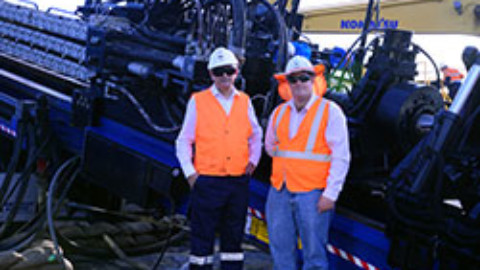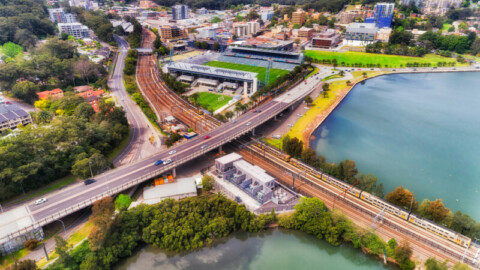In this ongoing interview series, we talk in-depth with the end users of pumps across a range of industries and applications. This edition interview Bruce Maunder, Sydney Water Senior Specialist in Pumping Systems, to get an inside view of Sydney Water.
Click to read Bruce discussing Sydney Water’s pumping operations in depth.

I have been working in the pumping industry for 44 years enjoying a variety of different aspects from trades assistant to managing servicing workshops and specialist technical support teams.
A friend of the family worked at Warman and suggested I come and get some experience during my holiday, which I did.
I initially started work with Warman International in 1969 at Artarmon on the shop floor assisting the fitters, boiler makers and pattern makers then progressing to the drawing board while completing my Engineering course part time. I was then offered a position as design engineer working on the design of a mineral processing thickener and then in development of their first High Voltage submersible pump. Later, I moved into the slurry pump sales followed by transition to the newly acquired Ornel Pumps sales team mainly involved with overseas tenders for supply of complete mechanical and electrical pumping equipment.
The next position was in 1979 with Kelly & Lewis Pumps in their Sydney office as Special Projects Engineer in the marine, fire protection and petroleum markets. This was followed by a move four years later, into the contracts group where I was involved in tendering and project managing the supply, installation and commissioning of mechanical and electrical pumping equipment to the likes of Public Works, Electricity Commission and Local Councils. In addition, I also managed the pump test bay at the new servicing workshop at Seven Hills following the closure of their KL Worthington Plant at Penrith. I left K&L at the time of the merger with Thompsons Castlemaine.
I then obtained a position with the Metropolitan Water Sewage & Drainage Board (later to become Sydney Water) in 1987 as the manager of the pumping technical support unit comprising 16 technicians and engineers engaged in providing design, project management, technical investigation, field pump performance testing, development of condition monitoring and maintenance standards.
Subsequent to this position there were periods which include managing the quality control inspectors and the management of around 100 trades personnel in the Fabrication/Machine workshops and Plant and vehicle workshop (when Sydney Water owned its own plant and vehicles). Although this experience offered some variety and challenges with industrial issues, it did highlight to me that as an Engineer I prefer the technical aspect of my work.
- Conversion from conventional Splitcase to dry mounted submersible pumps at SP0112.
- Natural gas power emergency pump at SP0498.
- Progressive cavity pumps at SP1167.
- One of two new pump clear water pumps at Sydney Water Desalination plant.
- Refurbished pumps with new motors at WP0001.
- One of four new dry mounted submersible pumps at SP0414.
- One of about 25 packaged booster pumps for low pressure area in distribution system.
- Units 5 and 6 Raw Sewage pumps at North Head STP.
- TEPS pump station at St Marys STP with 4 Archimedian screw pumps – one enclosed screw (below) the other three are open screw type.
What types of pumps have you worked with?
I have come across most types of pumps within the water and wastewater market ranging from a couple of kW to several thousand kW and from progressive cavity, submersible, borehole, self-priming, BPO, split case, vertical turbine, archimedes screw and canned pumps and with power from various sources such as electric motors, diesel/natural gas engines and hydraulic motors.
One of the more unusual installations is four vertical turbine effluent pumps at our Bondi STP powered by a 1 MW fixed speed motors driving through planetary gearboxes then a variable speed hydraulic couplings with their associated oil supply and cooling systems. They have an on line vibration and temperature monitoring system for most bearings in the drive train.
We had two pumps installed at WPS174 at Burrawang pumping station which comprise a 2 metre diameter discharge vertical turbine pump and a fixed speed 4 MW motor weighing 40 Tonne and a 12 Tonne flywheel (to minimise water hammer). Due to cavitation damage the impeller had to be replaced. To minimise costs and time requirement the wet well was isolated and dewatered, the impeller was removed with the pump in situ. The wet well was then re-flooded and the impeller floated out through the inlet channel with the aide of divers.
We have had to carry out considerable modifications to the three 700 l/s archimedes screw pumps at our St Marys STP to achieve improved reliability after the elimination of older asbestos material in the lower pump bearing and replacement with the synthetic alternatives offering completely different properties.
Outside the water industry I have been associated with diesel and electric fire pumps with controls to meet NFPA and Australian Standards, centrifugal pumps to meet API610 specification for petroleum industry requirements and pumps to military specification. These latter pumps can start life as a simple centrifugal design which, in a production environment, may cost say $5,000 and end up being $500,000 to meet the stringent design and quality control requirements.
How has pump technology and applications changed throughout your career?
Similar to most other equipment the pumps used were designed and built in Australia by Australian companies and in most cases, were engineered specifically to meet each customers’ requirements, whereas the pumps supplied now are mass produced in Europe and more commonly in Asia.
Based on total lifecycle costing analysis and with the development of larger submersible pumps Sydney Water has transitioned from the conventional sewage split case pumps to only use dry mounted submersible pumps where ever possible for renewals. Similarly larger sewage stations currently in design or construction will now be of wet well submersible type due to substantial cost savings.
There has been some minor improvement in pump efficiency, but the major changes have been the reduction in the size of the pump by operating at higher speeds and velocities to achieve the same performance at reduced relative capital cost. There was a trend for solids handling application with the smaller pumps to an increased possibility of impeller choking which in turn has required more sophisticated impeller designs to compensate.
With the advent of Computational Fluid Dynamics (CFD) software sump and pump designs can now be carried out on the computer with very accurate results whereas pump designed previously were based on known tested designs which are either scaled up or down and previous sump design were model tested.
Other important changes have been the relative cost effective and use of variable speed drives which can provide substantial improvement in operating flexibility, size of operating wet well/reservoirs, reduction in capital and operating costs.
Earlier vertical pump installations were very much hit and miss with regard natural frequency of the pump unit structure. It was unlikely that there would be a problem with fixed speed pumps, however, with use of variable speed pumps there is a much higher chance that the natural frequency will lie within the operating range. With the advent of modal analysis software allows these problem areas to be identified early and designed out.
All of the major suppliers now provide either online or standalone pump selection programs to aide pump selection, placing all the performance and pump technical information for standard production pumps at the designers finger tips for the various alternatives.
With increased availability of more advanced material and development of new protective coating systems, we are now able to refurbish pump to achieve much longer periods between overhauls.
With cost limits per household placed on capital cost to provide sewage systems in outlying areas of Sydney, the use of traditional gravity sewage system have been replaced with low pressure systems which require substantial requirements for maintenance with tanks and pumps located at each property.
What is your current role?
My current role is not that far removed from the where I started 1987, in as much as I have a team of technical specialists working in the High Voltage, Instrumentation & Controls and of course, Pumping Support. We provide necessary input into development of specifications, scoping for replacement facility assets, design reviews, troubleshooting, commissioning and field testing of new pumping equipment including hydraulic systems. There is now an increased focus on commercial and safety aspects in all parts of the business.
I didn’t specifically choose pumps but as opportunities arose which lead me in the pump direction. As with more experience you gain once you are on a path it’s difficult to start again at the bottom in a different direction. There was then a natural progression into the positions which followed.
It’s nice to have the knowledge that you are contributing to improving the business operation. I have not regretted working in this industry and have thoroughly enjoyed this field of expertise.
Click to read Bruce discussing Sydney Water’s pumping operations in depth.



























